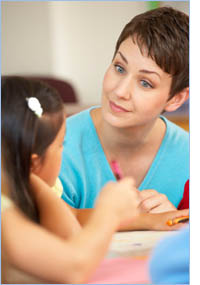
Autism/Pervasive Developmental Disorder (PDD) is a neurological disorder that affects a child's ability to communicate, understand language, play, and relate to others. PDD represents a distinct category of developmental challenges that share many of the same characteristics. The different diagnostic terms that fall within the broad meaning of PDD, include:
In the diagnostic manual used to classify mental disorders, the DSM-IV-TR (American Psychiatric Association, 2000), "Autistic Disorder" is listed under the heading of "Pervasive Developmental Disorders." A diagnosis of autistic disorder is made when an individual displays 6 or more of 12 symptoms across three major areas: (a) social interaction, (b) communication, and (c) behavior. When children display similar behaviors but do not meet the specific criteria for autistic disorder (or the other disorders listed above), they may receive a diagnosis of Pervasive Developmental Disorder Not Otherwise Specified, or PDD-NOS. Autism is one of the challenges specifically defined in the Individuals with Challenges Education Act (IDEA), the US federal legislation under which infants, toddlers, children, and youth with challenges receive early intervention, special education and related services. IDEA defines the disorder as "a developmental disability significantly affecting verbal and nonverbal communication and social interaction, generally evident before age 3, that adversely affects a child's educational performance. Other characteristics often associated with autism are engagement in repetitive activities and stereotyped movements, resistance to environmental change or change in daily routines, and unusual responses to sensory experiences.
Information from the National Institute of Mental Health and the Center for Disease Control and Prevention (CDC) indicates that between 2 to 6 per 1,000 children (from 1 in 500 to 1 in 150) have some form of autism/PDD. These disorders are four times more common in boys than in girls, although Rett's Disorder has only been reported and diagnosed in girls. The causes of autism or PDD are unknown. Currently, researchers are investigating areas such as brain development, structure, genetic factors and biochemical imbalance in the brain as possible causes. These disorders are not caused by psychological factors.
Some or all of the following characteristics may be observed in mild to severe forms:
Children with autism or PDD vary widely in abilities, intelligence, and behaviors. Some children do not speak; others have language that often includes repeated phrases or conversations. Children with more advanced language skills tend to use a small range of topics and have difficulty with abstract concepts. Repetitive play skills, a limited range of interests, and impaired social skills are generally evident as well. Unusual responses to sensory information—for example, loud noises, lights, certain textures of food or fabrics—are also common.
In the U. S., nearly $1 billion over the next five years (2007-2012) has been authorized to combat autism through research, screening, early detection, and early intervention. The National Institutes of Health and the CDC are the lead entities conducting and coordinating multiple research activities. On the education front, the PDA Center at the University of Washington has several sites around the country that provide training and support to schools and families for students with autism spectrum disorders. Research on instructional interventions for children with a broad range of needs is an ongoing national endeavor.
Early diagnosis and intervention are very important for children with autism/PDD. Special education programs for students with autism/PDD (ages 3 to 22) focus on improving communication, social, academic, behavioral, and daily living skills. Behavior and communication problems that interfere with learning often require the assistance of a professional who is particularly knowledgeable in the autism field to develop and help implement a plan which can be carried out at home and school. The classroom environment should be structured so that the program is consistent and predictable. Students with autism/PDD learn better and are less confused when information is presented visually as well as verbally. Interaction with nondisabled peers is also important, for these students provide models of appropriate language, social, and behavioral skills. Consistency and continuity are very important for children with autism/PDD, and parents should always be involved in the development of their child's program, so that learning activities, experiences, and approaches will be most effective and can be carried over into the home and community. With educational programs designed to meet a student's individual needs and specialized adult support services in employment and living arrangements, many children and adults with autism/PDD grow to live, work, and participate fully in their communities.
Work together with the student's parents and other school personnel to create and implement an educational plan tailored to meet the student's needs. Regularly share information about how the student is doing at school and at home.
|
|||||
 While there are subtle differences and degrees of severity among these conditions, treatment and educational needs can be very similar for all of them.
While there are subtle differences and degrees of severity among these conditions, treatment and educational needs can be very similar for all of them.